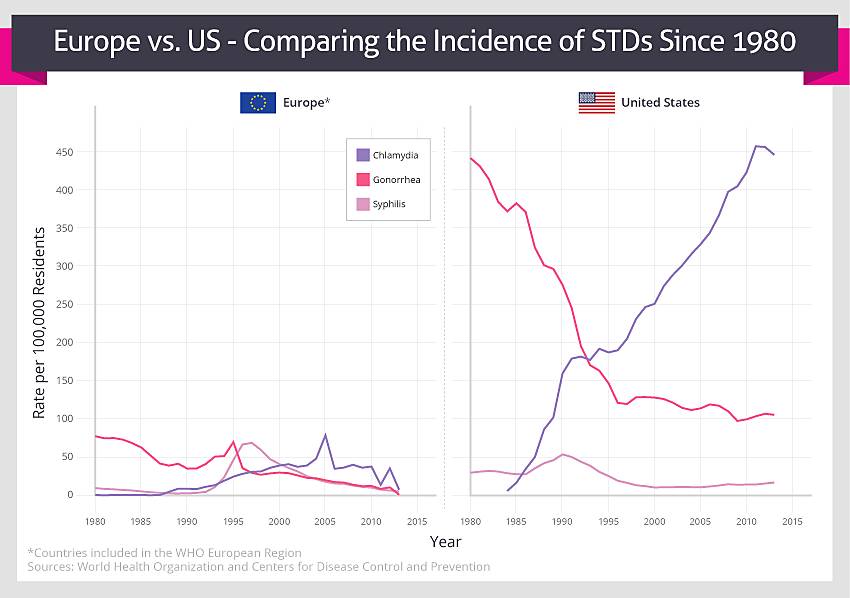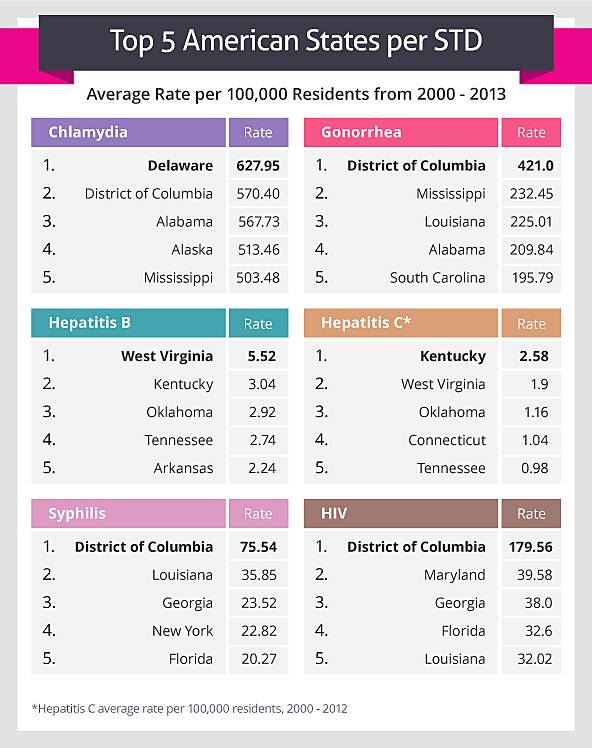
Sexually Transmitted Diseases Across Space and Time
We often hear the words herpes, gonorrhea, and chlamydia in a comedic context, but anyone who has an STD knows it’s no laughing matter. It’s something you may have to live with for the rest of your life. It’s scary. It’s embarrassing. It’s often confusing. But if you’re one of those people, you’re not alone. Not even close.
Across the world and across time, these diseases have affected the lives of many. See for yourself:

In terms of STD incidence rates, there is a stark difference between the United States and Europe. After analyzing STD incidence data collected from both the World Health Organization (WHO) and Centers for Disease Control and Prevention (CDC), we were able to track the rates over time of three STDs: chlamydia, gonorrhea, and syphilis. When you look at the graphs, you can see two very different tales being told.
According to data gathered from the WHO, Europe has managed to keep the incidence of STDs relatively low. We can see one spike for chlamydia in 2005 and increases in gonorrhea and syphilis in the mid-1990s. Outside of that, there were no drastic increases in these STDs in Europe.
What occurred with STD rates in the United States is more alarming. Gonorrhea rates, which dwarfed the rates of the disease in Europe, declined drastically. That’s the good news. The bad news is that the US’s gonorrhea incidence still eclipses that of its European counterparts. Worse yet is how much the US’s chlamydia incidence has risen over the same period of time. Rates are sky high compared with statistics across the sea.
STDs With the Most New Cases per European Country
Ever wonder which STD is contracted most frequently in France? The map above highlights which STD had the most new diagnoses annually in a given country, averaged from 2000 to 2013. Certain STDs seem to rule certain regions. For example, among northern European and eastern countries, chlamydia was typically the disease with the most new cases. In Germany and Poland in central Europe, hepatitis C was the most frequently diagnosed STD. In southwest Europe, France, Spain, and Italy, there were more new HIV cases than any other STD. However, on a per capita basis, new diagnoses of STDs – especially chlamydia – are still far less common in Europe than in the United States.

New Cases of STDs per US State
The heat maps below show the changes over time in the per capita rates of new cases of chlamydia and gonorrhea across the United States. Notably, Washington, D.C., requires its own scale due to its very high rate of STDs, with peak rates of gonorrhea more than three times higher than the peak rate among the 50 states. The District’s Department of Health acknowledges a struggle of epidemic proportions with chlamydia, gonorrhea, and other STDs, as well as hepatitis and HIV.
The CDC has attributed its success – and failure – in combating sexually transmitted diseases to education and access to healthcare.

Throughout the past three decades, reports of newly diagnosed cases of chlamydia have risen substantially across the United States. Although chlamydia is one of the most commonly reported diseases, the CDC notes that this apparent rise is actually due to increased testing rather than an actual jump in cases.

Unlike chlamydia, the number of newly diagnosed cases of gonorrhea per year appears to be on a relatively steady decline since 1984. While the CDC recognizes that new antibiotic-resistant strains of gonorrhea pose a threat, they also point out that levels of gonorrhea have reached a historic low.
Top 5 European Countries per STD
Below, you can see the top 5 European countries by STD incidence. Iceland is known for its great scenery and wonders of nature, but while the island houses many natural beauties, it also sits No. 1 on the top five for chlamydia, hepatitis B, and hepatitis C infections in Europe. It is also in the top five for HPV. Don’t let hepatitis scare you, though – the rates are minuscule compared with chlamydia rates. Russia had the most top five placements on these not-so-flattering charts, showing up in five of the eight lists.

Top 5 US States per STD
Below you can see the top 5 US states by STD incidence. You’d think being governed by the federal government’s strict standards would ensure Washington D.C. was relatively STD free. Not so. In fact, the nation’s capital is the place where HIV, syphilis, and gonorrhea are diagnosed at the highest rates. D.C.’s own health officials have said its HIV rates are higher than rates in West African nations. They’ve pointed out the District’s massive rates of HIV and AIDS are linked to delays in treatment after diagnosis, a lack of testing, and misconceptions about susceptibility to HIV/AIDS.

In general, the areas with the most new STD cases were states surrounding D.C., including Delaware, Maryland, and West Virginia. The Deep South states such as Alabama, Mississippi, and Georgia also had high rates of STDs.
Sexually Transmitted, Socially Awkward
STDs are one of the few topics that remain taboo in today’s culture. Some would even argue we go too far when we talk about sex at all, much less the potential hazards that come from the act.
But we need to be aware that these conditions are lurking out there and aren’t just punchlines on TV shows and movies. STDs can happen to you if you’re not careful – and sometimes even when you are.
While we think it’s important for people to know the facts about STDs, we also understand feeling the need to be discreet if you’ve contracted one. Visit onlinedoctor.superdrug.com for quick, easy advice and the products you need to check for and treat an STD — or prevent one entirely.
Methodology
We combed through the WHO and CDC databases to gather the most recent data on STD incidence across the European region and the United States. The STD with the highest incidence per European country was determined by averaging all available STD rates from 2000 to 2013 per country. The STD with the highest average rate per 100,000 residents was selected as the most commonly diagnosed STD.
Fair Use
We grant permission to use the images found on this page freely. When doing so, we ask that you kindly attribute the creators by linking to onlinedoctor.superdrug.com and this page so your readers can learn more about the project and its methodology.
Sources
- https://www.cdc.gov/hepatitis/statistics/index.htm
- https://www.euro.who.int/en/data-and-evidence/databases
- https://wonder.cdc.gov/std-v2011.html
- https://gis.cdc.gov/GRASP/NCHHSTPAtlas/main.html
- https://webarchive.nationalarchives.gov.uk/20160105223339/http://www.ons.gov.uk/ons/rel/pop-estimate/population-estimates-for-uk--england-and-wales--scotland-and-northern-ireland/index.html
- https://webarchive.nationalarchives.gov.uk/20160105223720/http://www.ons.gov.uk/ons/rel/npp/national-population-projections/2010-based-projections/sum-2010-based-national-population-projections.html
- https://www.census.gov/data/tables/time-series/demo/popest/pre-1980-national.html
- https://www2.census.gov/programs-surveys/popest/tables/2000-2010/intercensal/national/us-est00int-01.xls
- https://www.stltoday.com/news/local/metro/st-louis-city-ranks-first-in-chlamydia-infection-rate-nationwide/article_bca5c137-1a31-50f1-ae47-487e29f83b52.html
- https://data.worldbank.org/
- https://www.euro.who.int/en/countries
- https://www.washingtonpost.com/wp-dyn/content/article/2009/03/14/AR2009031402176.html?sid=ST2009031402211
- https://www.washingtonpost.com/local/aids-infection-rate-remains-epidemic-in-district-report-finds/2011/06/15/AGpHyuVH_story.html
- https://doh.dc.gov/sites/default/files/dc/sites/doh/publication/attachments/2012AESRFINAL.pdf
- https://www.cdc.gov/std/gonorrhea/arg/
- https://www.cdc.gov/std/stats/